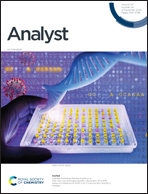Signal amplification surface-enhanced Raman scattering immunosorbent assay of human chorionic gonadotrophin based on repeated enzyme biocatalytic precipitation
Abstract
A novel surface-enhanced Raman scattering (SERS) immunoassay method based on tyramine signal amplification (TSA) technology triggering the formation of enzyme repeats on an enzyme-linked immunosorbent assay (ELISA) was designed for highly sensitive detection of human chorionic gonadotropin (hCG) using enzymatic biocatalytic precipitation toward o-phenylenediamine (OPD). Initially, a horseradish peroxidase (HRP)-labeled hCG antibody was fixed by the double antibody sandwich method, and then a tyramine-HRP conjugate was used to form HRP repeats by triggering the immobilized HRP on ELISA with the aid of H2O2. In the presence of the target hCG, the HRP repeats carried by the sandwich immune complex catalyzed the oxidation of OPD to produce product molecules with different structures, resulting in changes in the SERS fingerprint spectrum. The analytical performance of the SERS immunoassay was studied in detail using SERS spectral characterization. Under the optimum conditions, the immunosensor displayed a working range from 1 IU L−1 to 16 IU L−1 with a detection limit (LOD) of 0.17 IU L−1 relative to the target hCG. Compared to the traditional SERS immunosensor, a higher detection sensitivity can be obtained. Therefore, this work provides a new strategy for hCG detection and inspiration for the construction of sensitive and efficient immunosensors.



 Please wait while we load your content...
Please wait while we load your content...